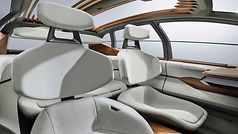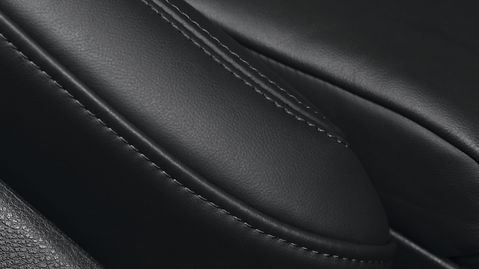“Haptics and digitalisation are not opposites.”

Christian Labonte | Responsible for design communication and strategic projects within Audi Design, Ingolstadt.
Surface finishes are becoming more and more smooth, hard-wearing and glossy. Do true haptics have any real value any more – especially when it comes to automotive design?
The tactile quality of products with their surface finishes, switches, handles and displays amplifies our emotional response. Haptics are a dimension with particular value especially where cars are concerned. Imagine a new car at a motor show. An inquisitive visitor has no other option but to “grasp” the vehicle because they intuitively want to understand their environment through touch. They sit inside and feel everything. As a brand, we want to honour our promise of first-class bodywork design through the quality of the interior as well. This includes all of the materials, surface finishes and the chosen colour palette. Ergonomics also play a role – with haptics contributing to the quality of the operating process. If the driver, for example, sets the temperature using a touchscreen, the user receives visual feedback on the display. There is also a vibration at their fingertips as haptic feedback. This added value which makes my life easier through details that make me feel secure in my environment increases the emotional connection to the car.
Digitalisation versus material things. How do you strike a balance in your profession?
Digitalisation can simplify and make our lives easier in many areas because it allows access to knowledge and, in turn, decisions. At the same time, I am aware of a trend towards people seeking analogue experiences and sensual moments in the face of digital omnipresence. Artisan products are once again in demand, particularly when they have a powerful story behind them and you can learn where the material used was grown or made and who harvested or cultivated it and how. Unique products that are carbon-neutral are the most sought-after. A specific example is the user interface. Most of our competitors arrange the screen as an expressive stand-alone unit. In contrast to this, we have deliberately integrated it into the interior so that it is similar to the familiar control panel. The touchscreen is now situated where decorative surfaces previously adorned the interior space. You could say that we are pursuing a gentle revolution.
Will the good old stand-alone types continue to exist? Or will everything become more homogenous and interchangeable?
Definitely. Design is highly valued and its value is continuing to increase. E-mobility has made the entry barrier to technology much lower than ever before. Many new competitors have appeared within a very short space of time. This is because one does not need 100 years of experience in automotive engineering to be competitive. Design provides the necessary differentiation among the competition – including within a company's own product portfolio – in order to offer the customer unexpected added value. In short, it is about creating consistency and logical consequence in the brand-specific storyline.
Which parameters do you use to develop a language of design to give Audi an identity? We focus on the design features that have been setting the Audi brand apart for decades.
As an all-wheel drive brand we highlight, for example, the quattro drive by using wheel arch trims with a powerful look, thereby making “Vorsprung durch Technik” visible. The radiator grill is also an important characteristic feature of our brand and also allows for differentiation between the A, Q and R families. In addition to the combustion engine industry, we also set ourselves apart with design features for our e-tron models – our electric cars.
The desire for panoramic and unrestricted views is having an increasing impact on architectural design. How does this manifest itself in automotive design?
If you look at the show cars from recent years, they always represent a little of the future of the brand. Concepts characterised by transparency represent a positive feel for the future, which can also be seen in the series-produced cars. This is created in particular by sunroofs, which convey the impression of openness and lightness. Yet there is nothing stopping the panorama glazing being converted to translucent or completely opaque in future. The car would then become a place of retreat.
The haptics of which object from your environment / from nature impress you the most?
Natural and unaltered materials fascinate me. As a trained cabinet maker and industrial designer, I have a particularly strong affinity for timber. Many years ago, I found a large and unusually shaped piece of driftwood while I was walking by the Mediterranean Sea. It came from a conifer and had spent many months in the water. The shape this created is unique. It inspires the imagination and you can find strange faces and animals in the grain of the wood. In principle, this cannot be manufactured industrially – and that is a good thing. What is important is that these objects have a story within them to which I can develop an emotional connection.
What role does the transition between inside and outside play in your home life or even at work? How important is it for you to have a sensory link to nature?
Nature gives me inner balance. I spent the first decades of my life living in an urban environment – I grew up in the Rhineland near Düsseldorf, studied in the Ruhr region and lived in Ingolstadt near the city centre. However, two years ago we moved to the countryside. Nature is a much bigger part of family life there and everything is experienced much more intensely: the seasons, the sun, the snow, the wind, temperatures etc. In contrast, urban spaces are important for inspiration and social interaction. Another example is my workplace at Audi. About one-and-a-half years ago, we moved with the entire Design team of 400 people to a new Design Center. The building was designed by gmp Architekten and Gerkan, Marg und Partner with high requirements in terms of building technology and security. To be able to design models in the best possible way, we need large model halls which also ensure confidentiality is maintained. As a result, a completely glazed building was created with maximum transparency that ensures the highest security standards. From the inside, there is a feeling of total openness and integration into the surroundings. The setting sun sometimes makes us pause for a moment, fascinated, watching the horizon. This naturally pays dividends in terms of our feeling of wellbeing.
Where is your favourite place to look at the views?
At the house in the countryside that I mentioned before. On a clear day, I can see the Zugspitze from my garden and from the south-facing rooms I can see right past Munich to the Chiemgau Alps. For me, those are very special moments.






- Work material (e.g. tender specifications, BIM objects, CAD data, catalogues)
- Note content
- Direct contact to Schüco